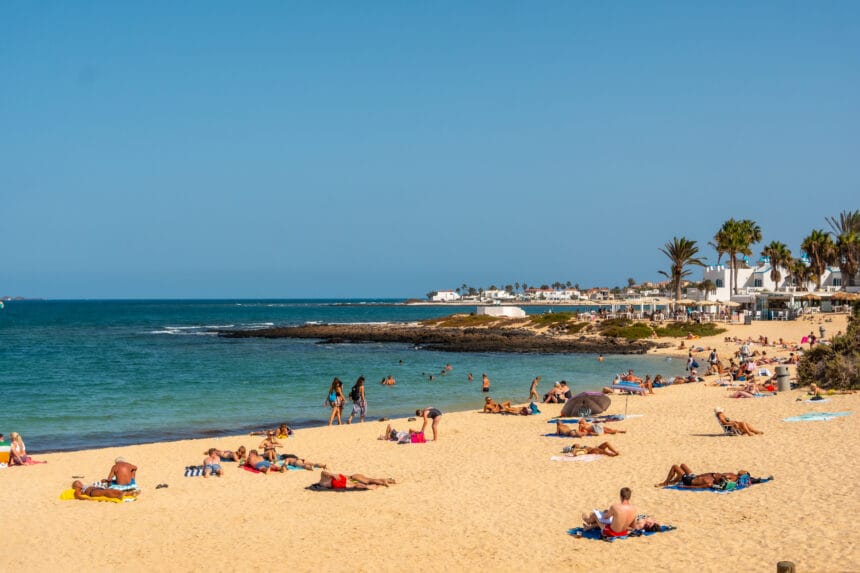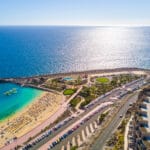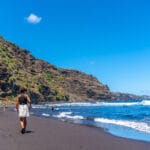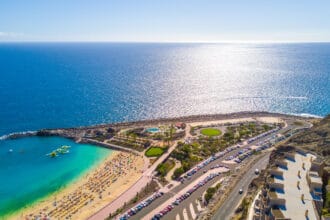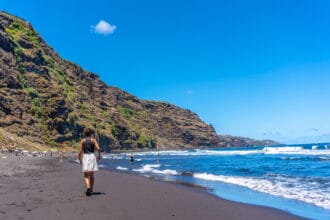I used to think island hopping meant choosing between similar beaches with slightly different cocktail menus. Then I spent three weeks in the Canary Islands and realised I’d been doing it all wrong.
These seven Spanish islands, floating in the Atlantic off Morocco’s coast, are nothing like each other. I mean, really nothing alike. It’s almost bizarre how different they are, considering you can see one from another on a clear day.
Tenerife: The Showstopper
Let’s start with the obvious one. Tenerife is where most people begin, and I can see why. Mount Teide dominates everything – Spain’s highest peak rising from the sea like something out of a fantasy novel. The cable car up there is terrifying if you’re scared of heights, which I discovered I am. But the views are worth the white knuckles.
The black sand beaches threw me completely. Playa Jardín looks like someone scattered charcoal across the coastline. It’s striking, though perhaps not what you’d expect from a beach holiday. The locals seem quite proud of it, and rightly so.
Gran Canaria: The Surprise Package
Gran Canaria caught me off guard. Everyone talks about Las Palmas and the southern beaches, but the interior is completely different. Rolling green hills, dramatic ravines, pine forests that smell incredible after rain. I spent a day driving through landscapes that reminded me of Scotland, then ended up on a beach that could have been the Caribbean.
The sand dunes at Maspalomas are worth seeing, though they’re a bit touristy. Still impressive, mind you. Like a mini Sahara plonked next to the ocean.
Lanzarote: The Alien World
This is where things get weird. Lanzarote feels like Mars with better weather. The whole island is basically one big volcanic sculpture, twisted and dramatic and utterly unlike anywhere else I’ve been. César Manrique, the local artist, turned this into an advantage rather than hiding from it.
Timanfaya National Park is extraordinary. They cook food using heat from the ground, which sounds like a gimmick but actually works. The landscape is so otherworldly that I kept expecting to see a film crew around the next corner.
La Palma: The Green One
La Palma calls itself ‘La Isla Bonita’ and it’s not being modest. This island is lush and green and feels more like a tropical paradise than the others. The hiking here is excellent, assuming you’re reasonably fit. The Caldera de Taburiente is this massive crater you can walk into, though I’d recommend proper boots. Trainers don’t cut it on volcanic rock.
The recent volcanic activity has actually created new land, which is fascinating from a geological perspective. Though I imagine less fascinating if you lived nearby.
Fuerteventura: The Windy One
Fuerteventura is all about the wind and waves. If you’re into surfing or windsurfing, this is your place. The beaches go on forever – proper golden sand this time, not the black volcanic stuff. It’s perhaps the most ‘normal’ looking of the islands, if that makes sense.
The interior is quite barren, almost desert-like. Not unpleasant, just different. Very peaceful, actually.
La Gomera: The Forgotten Gem
La Gomera feels like stepping back in time. Smaller, quieter, less developed than the others. They still use a whistling language here to communicate across valleys, which sounds made up but apparently isn’t. I heard it once and couldn’t make head or tail of it, obviously.
The laurel forests are UNESCO protected and feel ancient. Proper fairy tale stuff, all misty and mysterious. Though the roads are terrifying if you’re not used to mountain driving.
El Hierro: The Secret
El Hierro is tiny and feels almost forgotten. Which is probably its appeal, really. It’s the most sustainable of the islands, running mostly on renewable energy. The diving here is supposed to be world-class, though I can’t verify that personally.
It’s the sort of place you go to properly switch off. No major attractions, no crowds, just peace and quiet and dramatic coastlines.
Why This Changes Everything
Here’s what struck me about the Canaries: you could spend a week on each island and have seven completely different holidays. Beach lounging on Fuerteventura, hiking on La Palma, cultural exploration on Gran Canaria, otherworldly landscapes on Lanzarote.
The weather helps, obviously. Warm year-round without being oppressive. Perfect for escaping British winters, though I suppose everyone knows that already.
What I didn’t expect was how easy it is to island hop. Ferries run regularly, flights are cheap and quick. You could do three islands in a week if you wanted, though I think that might be rushing it.
The food surprised me too. Lots of fresh fish, interesting local cheeses, those wrinkly potatoes with green sauce that appear everywhere. Better than I expected, honestly.
I suppose the only downside is that some areas feel quite developed. Parts of Tenerife can be overwhelming if you’re after peace and quiet. But then again, that infrastructure means everything works smoothly.
Perhaps I’m overselling them, but the Canary Islands genuinely changed how I think about island holidays. They’re accessible, diverse, and offer something completely different from the usual Mediterranean options. Just don’t expect them to stay under the radar much longer.


